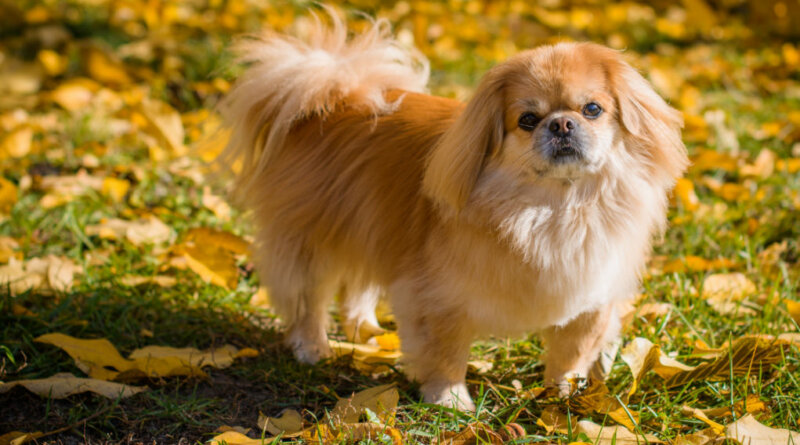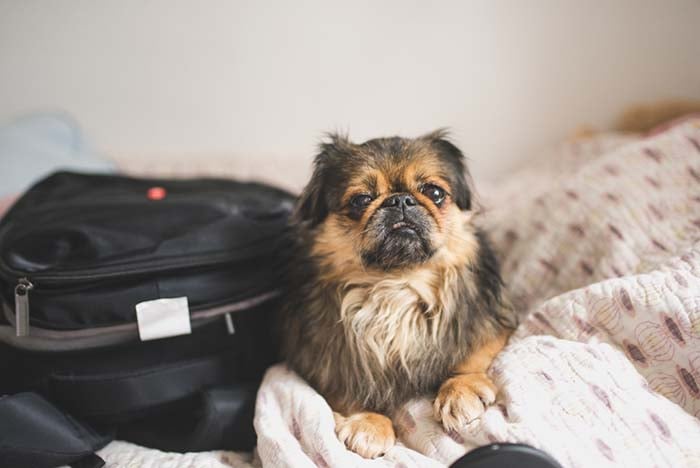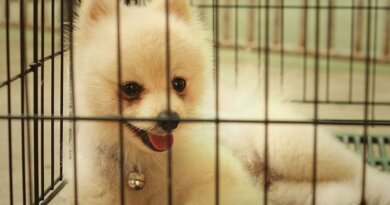Pekingese Dog Breed Profile – Top Dog Tips
Are you looking for a miniature toy breed that is neither aloof nor clingy to keep you company?
Do you want to learn more about the Pekingese dog breed and what makes them so adorable and lovable?
These charming dogs have won about five awards at the Westminster Kennel Club Dog Show and are quite a delightful sight.
With a royal history tracing back to ancient China in the 1860s, these dogs have a regal and aristocratic demeanor that every owner will admire.
Their large eyes, small muzzle, and luscious coat are guaranteed to give anyone loads of cute aggression.
If you’re thinking of getting one, it’s best to have sufficient information and know what to expect.
Here we will guide you through what you need to know about the Pekingese dog breed—from their personality, size, family-friendliness, and history.
So, without further ado, let’s get started!
Pekingese Dog Breed
Every dog breed has unique features that distinguish it from others. Dog owners may opt for them based solely on these characteristics.
While no dog breed is worse than the other, choosing one compatible with your personality and lifestyle will help avoid potential problems.
Here, we’ll discuss the Pekingese dog breed to help you make an informed decision:
Height and Weight
Pekingese grow up to be 6-9 inches. While they may seem small, don’t be deceived by their adorable appearance.
Under their fluffy fur lies a stocky and muscular build that may weigh up to 14 pounds.
This is regarded as quite heavy (relative to the overall size) in the doggo world.
Their diminutive stature makes them apartment-friendly dogs since they don’t require much space to rest, walk, and play.
They’re cuddly, so expect their resting place to be on your lap.
Coat
Pekingese dog breeds have a long double coat that sheds a moderate amount.
It’s thick and luscious, so you’ll have to be mindful of the required bathing, brushing, and trimming for maintenance.
This may mean an additional grooming cost for people who don’t have the expertise to do it at home.
Keep in mind that they’re not hypoallergenic, making them an unfit choice for people with allergies.
The coats come in diverse colors, including biscuit, black, cream, fawn, gray, red, white, and more!
The standard markings that characterize its appearance include a part color, a black mask, and white markings over the body.
Features
Pekingese have long and low bodies that add to their adorable toy breed persona.
Their small muzzles and prominent eyes will melt the heart of anyone who ventures to look at these cute beings.
Their long ears framing a round head somehow add charm to their endearing proportions. But don’t let the childlike appearance fool you.
Under their captivating looks lie strong-boned regal dogs that are loyal to their core.
How To Care for Pekingese Dog Breed
Do you already own a Pekingese? Are you thinking of getting one?
Here are four things you should be aware of to ensure optimum health for your doggo:
Exercise
Pekingese do not need a lot of exercises. A minimal 30 minutes will be enough to keep them fit.
Their small noses make them susceptible to breathing problems, so don’t overdo it.
Training
Pekingese are known to be stubborn, which may make training difficult. We recommend avoiding harsh physical corrections if they don’t act as per instructions.
This is likely to increase their aggressive behavior. Instead, a firm voice is much more likely to get the job done.
Grooming
The Pekingese has a long, thick coat that requires daily brushing to keep it healthy.
Not doing so may result in tangles and mats that will need to be shaved off by a professional groomer.
You will have to bathe your dog regularly since their abundant coat requires frequent shampooing to stay strong.
Diet and Nutrition
Pekingese generally need 300-400 calories per day to stay active and fit.
We recommend incorporating the following food to keep your pet healthy:
- Meat-based protein source for a healthy immune system
- Animal and vegetable fats to maintain stable energy levels
- Vegetables and fruits to increase the intake of vitamins, minerals, and antioxidants
Causes of Pekingese Excessive Barking
There is no fixed answer to why the Pekingese breed loves barking.
Some experts claim they only do so to alert towards potential threats. In truth, it all depends on their heredity and environment.
They’re not as loud as fellow toy breeds such as Australian Terriers, Border Terriers, and Chihuahuas.
But they may bark a lot depending on certain factors. If your Pekingese is constantly woofing, the following underlying reasons may be at play:
1. Territorial and Protective Nature
While Pekingese are very friendly with those they love, they have a limited love for strangers and other animals.
This means that their exposure and level of socialization during puppyhood will shape their behavior in adulthood.
Pekingese with minimal socialization may bark excessively when a human or any other animal comes near their domain or spot.
This may be due to survival instincts ingrained in their psyche. But, this barking will be less if the dog grows up around loads of people since they will not feel as threatened.
2. Fear
Overall, Pekingese have a headstrong personality. But they may get scared by certain noises and get startled.
The fear may manifest in the form of excessive barking as a defense mechanism.
They may also do so to direct their owner’s attention to the source of the perceived threat.
3. Feeling Lonely
Pekingese are affectionate animals that demand a considerable amount of love and attention.
While they’re not clingy per se, they enjoy casually lounging on your lap. Leaving them alone for hours on end may trigger feelings of loneliness.
This will lead to barking to get your attention. This behavior may also develop into attention-seeking tendencies if left untrained.
4. During Socialisation
Pekingese aren’t antisocial and may react with wagging and leaping when greeting friends.
This is their range of expressions when interacting with anyone. It symbolizes happiness and excitement.
5. Social Anxiety
Pekingese love their owners and want to spend time with them. Any prolonged distance may lead to the development of social anxiety.
This will prompt your Pekingese to bark to get your attention.
While harmless in the beginning, it may also develop into a bad habit and an unhealthy coping mechanism.
It’s best to give your dog the desired attention and train them properly.
Can You Train a Pekingese To Bark Less?
Yes, you can train a Pekingese to reduce the barking. Here are five ways to help you do so:
1. Ensure Regular Exercise
Daily exercise through jogging, running, and games are essential for optimum health.
Not only will it keep your dog fit, but it will also stop your Pekingese from barking since it’ll be too exhausted to do so.
Even a small game of fetch before bedtime will keep your dog from unnecessary barking as they doze off to sleep.
2. Consistent Socialization To Minimize Fear
As discussed, dogs bark when they feel threatened.
Slowly exposing your dog to other individuals and animals may help them feel safer. This will help minimize excessive barking.
3. Identify the Reason and Eliminate It
This is perhaps the most important of all. If your dog is barking out of fear, serving food will not fix the problem.
Making a correct diagnosis and treating the problem accordingly is crucial here.
4. Do Not Respond to The Barking
Your dog may be barking just to get attention. You will have to train your dog to ask for it more gently.
We recommend spending quality time and staying silent if the barking persists. This will break the mental association between barking and attention.
You can also reward silence with treats for the best results.
5. Contact a Professional
Coming up last, getting a professional canine trainer will be the ideal way of resolving the issue.
If the other strategies don’t work out, leaving it to trained and competent people will help build healthier dog habits and behavior.
Are Pekingese Good Family Dogs?
Yes, Pekingese are affectionate and lovable dogs for people with families. They’re sure to charm every member with their innocent eyes and adorable looks.
They’re neither clingy nor aloof, making them perfect for working people who want company without excessive responsibility.
This comes with an exception. Pekingese have a royal and regal history.
This means they don’t necessarily like it when they’re teased, carried excessively, woken up from sleep, or chased around the house.
Since toddlers and young children may be susceptible to such behavior, we do not recommend getting a Pekingese for people with young children.
But if your household is mainly composed of teenagers and adults, a Pekingese will be a wonderful and loving addition.
Do Pekingese Dogs Bite?
Pekingese are generally not aggressive and are unlikely to bite anyone.
But their protective instincts may arise when anyone encroaches on their territory. This can cause them to resort to biting as self-defense.
They may also do so out of nervousness and anxiety when meeting new individuals or people.
This is another reason why early socialization is so important for these pups.
If they’ve had exposure to multiple people and surroundings, they won’t feel as anxious, threatened, or unsafe when introduced to new stimuli.
Pekingese Lifespan and Health Concerns
Pekingese generally live up to 12-14 years. They don’t get sick a lot.
But they’re purebred and may be susceptible to hereditary diseases. It’s important to ask your breeder about potential concerns.
Some minor health concerns include patellar luxation, trichiasis, and skin fold dermatitis.
Their small noses may incline them towards breathing problems, especially if exposed to extra heat or exercise.
Ensuring a healthy and cool climate is essential for optimum health.
Why Is the Pekingese Breed So Rare?
The Pekingese breed is quite rare now. But this wasn’t always the case.
Since they were bred as companions for imperialists, their aristocratic demeanor was quite a luxury.
Before 1911, the limited numbers of Pekingese and their image as dogs purely for the royal families established them as superior, popular, and desired.
This was when things went downhill. As China became established as a republic, the dogs started becoming widely accessible. This led to them slowly losing their dignified status.
They got so large in number finding them mating with stray dogs on the streets of Beijing became a common sight.
It’s the human psyche to own something unique and special. And while we do not condone treating animals this way, it is what happened at the time.
As the numbers grew, inbreeding with other local dogs began.
This eventually led to increased susceptibility towards health concerns such as consistent shedding, a senseless demeanor, and reduced training ability.
This further decreased the appeal of the once-magnificent breed.
These days the Pekingese dog breed is quite rare. Most of them are imported and foreign.
The concerns mentioned above are not found in Pekingese since they are purebred. They make great companions and can range from $750 to $3000.
Watch the following YouTube video to learn more about the history of the Pekingese dog breed:
Pekingese Dog Breed: Summary
If you’re looking for a loyal, affectionate, and protective dog, the Pekingese will definitely suit you well. They have charming personalities and are devoted to those they know.
But you may want to ensure gradual socialization with other family members and animals since they are not the friendliest with those they’re not familiar with.
It’s best to ask their previous owners or the breeder about their background since each Pekingese may have a different one, depending on its genetics and environment.
Bonding with these soft babies isn’t all that hard. While they may be stubborn, they are open to giving and receiving love.
So, expect a cozy snuggle buddy that will stick with you always!
READ NEXT: West Highland White Terrier Dog Breed Profile










